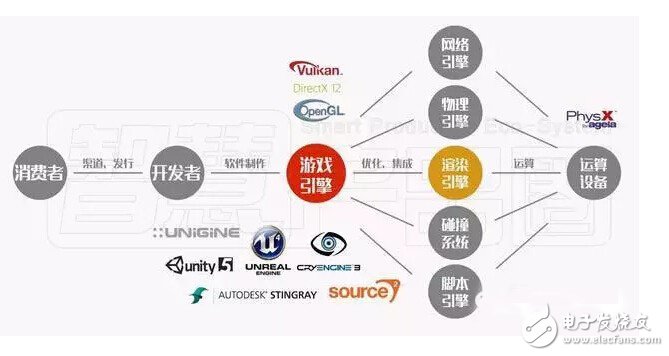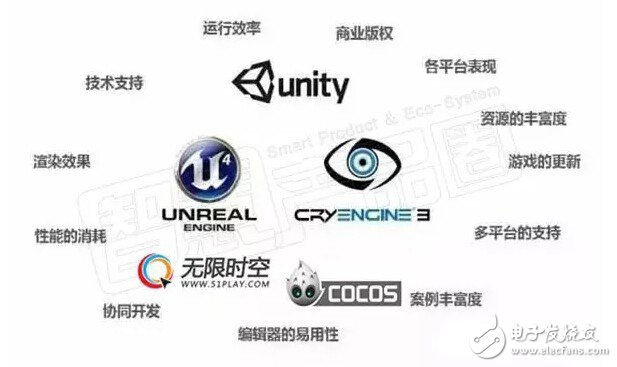Since Facebook's $2 billion acquisition of Oculus in 2014, a large number of domestic manufacturers have begun to devote themselves to the virtual reality industry, but most of them focus on hardware areas such as helmets and glasses, and the content is seriously lacking, and the core of virtual reality content development is based on the VR engine. It can be said that no matter which company is willing to buy a company-made VR helmet, the ultimate winner may be these VR engine companies. After all, millions of developers need VR engines to develop video games. With the rise of virtual reality, it will become the "darling" of the new era.
In the face of the VR wave, Unreal, Unity, CryENGINE, Cocos 3D game engines have followed suit, and are determined to seize this unique opportunity to establish their status as a river. A new round of VR engine battle is about to break out.
To this end, I visited domestic and foreign game engine companies, and analyzed and compared their products, hoping to give readers a better understanding of the technology and products.

First, the domestic and international mainstream game engine
At present, the mainstream engines in the domestic market include UE4 engine, CryEngine3, Unity 3D, Cocos 3D, etc. In addition, Beijing Unlimited Space Network Technology Co., Ltd. launched the first next-generation virtual reality engine in China, the infinite VR engine, which provides developers with New options beyond the above engines.
Unreal Engine 4
Unreal (short for UNREAL ENGINE) is currently the world's most well-known and most popular top-level game engine, accounting for 80% of the global commercial game engine market share. UE4 has a powerful rendering effect and uses the pbr physical material system, so its real-time rendering effect is completed, which can achieve the effect of vray static frame, and become one of the developers' favorite engines.
In Unreal Engine 4.7, the "VR Preview" feature was added. In short, this new option allows VR developers to immediately browse their work through the Oculus Rift for better development. In June 2015, Unreal Engine 4.8 was released, providing VR support for multiple platforms.
To further attract developers to join the UE camp, the UE4 engine announced that it can be downloaded for free, and this strategy has also achieved significant results - as of July 2016, the engine had more than 2 million developers, nearly double the previous one. In recent years, the UE4 engine has become a magic weapon for many VR gaming experiences.
Unity 3D
Unity3D is a multi-platform integrated game development tool developed by Unity Technologies that allows players to easily create interactive content such as 3D video games, architectural visualizations, real-time 3D animations, etc. It is a fully integrated professional game engine. Unity takes advantage of the interactive graphical development environment as its primary mode. Its editor runs under Windows and Mac OS X and can publish games to Windows, Mac, Wii, iPhone, WebGL (requires HTML5), Windows Phone 8 and Android platform.
Now, Unity's focus is on tuning the game engine to meet the needs of virtual reality developers. Unity 5.1 adds a "highly optimized" rendering pipeline to VR and augmented reality devices. It also adds native support for OculusRiftHMD, allowing developers to plug in their development tools and get them right away. The most anticipated virtual reality helmet, the Oculus Rift, has already been delivered, and 16 of the 30 playable games in the device were developed using Unity technology. In addition, Unity's technology is also very popular among developers who develop games for HTC and Sony Virtual Reality Helmets and Microsoft Augmented Reality Helmet HoloLens.
Unity's game engine has an advantage in low-cost devices that can be bundled with smartphones to let people experience low-end virtual reality technology. More than 90% of the games on the Gear VR, a virtual reality device jointly developed by Samsung and Oculus based on smartphones, are based on Unity technology.
CryENGINE
CryENGINE is a German CRYTEK company that produces a game engine for the latest technology DirectX 11. Cryengine is a next-generation game engine compatible with PS3, 360, MMO, DX9 and DX10. Unlike other competitors, CryENGINE handles physical effects, sounds, and animation without the support of third-party software. In short, this is a very versatile engine.
At the 2016 GDC Game Developers Conference, Crytek, the developer of Crysis, officially announced its newly developed game engine CryEngine 5, which fully supports DX12 and VR development, and is open source free! Crytek's most famous CE engine has created the "Crysis" series and "The Son of Rome", the visual performance of this engine has conquered the players around the world.
CryENGINE has not developed very well in recent years. In 2014, Crytek, the developer of the famous game engine CryENGINE, was on the verge of bankruptcy. Once the salary was not paid, until Amazon injected huge sums of money into it, the studio had a respite. Opportunity. Part of the failure of CryENGINE is that it is out of touch with the market. When CryENGINE enters steam to promote subscription-based payment for independent developers, u3d and ue have already established a perfect community. The official documents are incomplete and the success stories are rare, which restricts its development. . However, the arrival of the VR era has also brought new opportunities to CryENGINE.
Cocos 3D
Cocos 3D engine is a VR game engine developed by Touch Technology. It represents the works: fishing talent, my name is MT, 2048, etc. The users are mostly East Asian game developers, but most of them are small games.
At present, the Cocos engine is very large in China. It can not only help develop and develop games, but also realize the docking and input of VR hardware. The Cocos engine integrates integrated VR mode to facilitate developers to develop VR. But the Cocos engine was originally a 2D game engine, and the engine optimization for 3D and VR is not a one-off, so compared to Unreal, the international mainstream engine, there is a considerable gap between Cocos 3D, and more improvements are needed in the future.
Infinite VR engine
The Infinite VR Engine is the first next-generation virtual reality engine in China by Beijing Unlimited Space Network Technology Co., Ltd. It can greatly improve the operation efficiency while ensuring the effect of the next generation screen. The lower learning threshold will also help VR practitioners to produce high-quality VR works faster and actively promote the development of China's virtual reality industry.
The infinite VR engine has been developed over 5 years. It is understood that the infinite VR engine has done a lot of deep customization development for VR features, including multiple optimizations for VR binocular rendering features, support for mainstream head-mounted devices, mainstream handle input and gestures. The identification system also includes modules such as somatosensory simulation firearms and character positioning, and supports virtual reality 3D interfaces. The operation efficiency is higher under the premise of ensuring the same image quality. At the same time, the Infinite VR engine is also optimized for mobile platforms and VR, and has developed a complete set of software layer interface agents. Developers do not need to consider the SDK access issues of various helmets, only need to update the agent layer plug-ins at any time. You can support a variety of hardware helmets.
Second, the VR engine competition, each has its own characteristics and deficiencies
With the advent of the virtual reality of civilian use, major engine manufacturers have begun to lay out their own positioning, including engine business adjustment, business activities, product price strategy, and support for VR direction. But for developers, the choice of game engine is a big problem, need to consider engine performance, multi-platform support, development difficulty, commercial copyright, technical support and many other factors. Therefore, we make a simple comparison of all aspects of the above five engines.

In terms of engine rendering performance, UE4 engine and CryEngine3 rely on top graphics processing capabilities to achieve the best rendering results, followed by UnTIy and infinite VR engine. The cocos 3D engine was originally a 2D game engine. The rendering in 3D and VR is not as good as above. A few. VR is an experience-oriented technology, so the current VR from concept to project, all with strong image impact as the main indicator. Under the trend of this trend, UE4 contour rendering engine is of course more favored by VR developers. From April to July 2016, the number of registered developers on the UE4 platform increased by 500,000 to a total of 2 million.
In terms of multi-platform compatibility support, the Unity3D engine has the best cross-platform support, releasing games to Windows, Mac, Wii, iPhone, WebGL (requires HTML5), Windows Phone 8 and Android platform. UE4, CryEngine3 and unlimited VR engines focus on PC-side game development, while cocos 3D is more used in mobile-side game development.
In terms of development difficulty, cocos 3D, unlimited VR and Unity3D engine development is faster, the interface is also very easy to use, cocos 3D and Unity3D in the relevant development chain, whether it is resources or plug-ins are very perfect, in terms of development efficiency, definitely more Winning. The infinite VR engine has just been launched, and the expansion resources are not rich enough, which will cause certain inconvenience to developers. The work process of UE4 and CryEngine3 is complicated, the learning is difficult, the hardware requirements are high, and the developer needs to have a considerable understanding to fully exert the performance, and the development is difficult.
In terms of business cooperation, Unity has several different licensing fees, and its Pro version was $1,500 or $75/month at the time of this article. The pro version provides a lot of features not included in the free version, while UE4 and CryEngine 5, cocos engines are open source and free. However, if you want to get better technical support, you still need to pay for the service support.
In summary, the above five engines can be described as having advantages and disadvantages. But relatively speaking, Unity3D, cocos3D engine is more suitable for mobile VR games, UE 4 and CryENGINE have fascinating image capabilities, more suitable for the development of PC-side game masterpieces. The infinite VR engine, with its next-generation image quality, high efficiency, good start, and compatibility with various VR hardware, may also become a good choice for developers.
Fixed panel, FM electronic tuning radio
With USB mobile hard drive socket, SD card slot, compatible with MP3/WMA music format
Electronic volume control, color screen or LED or LCD display with external auxiliary audio interface
Audio output, pre-stored 18 radio stations, built-in electronic clock, pause-repeat-random radio radio search radio station/automatic storage radio function, loudness and mute function
Electronic digital song function, USB mobile phone charging, memory playback function, power supply: 12V or 24V
Optional features:
AM electronic tuning radio (plus 12 radio stations), sound adjustment: equal ring / bass / treble / balance
Audio playback effect: pop-rock-classic-jazz, with folder function, ID3 function, with Bluetooth maximum power output: 4*15W/4*25W/4*45W, with remote control
Fixed Panel,High Quality Fixed Panel,Fixed Panel Details, CN
Jiangmen soundrace electronics and technology co.,ltd. , https://www.soundracegroup.com